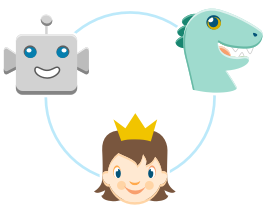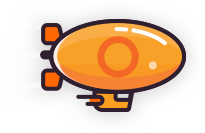Full Text
Hey, you're a scientist, like me! Come discover with Sid the Science Kid.
Hi, everyone, I'm Sid! And today I'm here at my school to talk to you about . . . rainbows!
Oh, wow! Look at all those amazing colors!
Do you know any of the primary colors? Here's a hint: there are three.
Let's see if Gerald knows what they are.
“Hey, Gerald, I have a question for you.“
“Hey, Sid!“
“So, do you know any primary colors?“
“Uh . . . yeah, yellow is a primary color, just like the color of my pants.“
“Yeah! Yellow IS a primary color!“
“Yeah!“
“Okay, two more to go! Hey, May, do you know any primary colors?“
“Sure, Sid. Red is a primary color, like your sweatshirt!“
“Okay, thanks!“
“Bye!“
“And one, two, three! And one, two, three!“
“Ooh! Hey, Gabriela! Wait for me! Do you know any primary colors?“
“Ooh! My favorite is blue, the color of the sky!“
Wow!
My friends know all three of the primary colors!
Gerald knew that yellow was a primary color.
And May—May told us red was a primary color.
Um, and Gabriela . . . hmm.
Oh yeah, Gabriela said blue was a primary color.
“Okay, everyone, recess is over! Let's go back to class!“
Yay! Let's go learn more about primary colors!
“All right, everyone, so here are the primary colors. Does anyone know why they're called the primary colors?“
“Because they make other colors?“
“Yeah, those colors make lots of other colors!“
“Um. Teacher Susie, I think we should make green!“
“Yeah, a pretty green!“
“Then you're in luck because we're going to make colors by mixing two primary colors together!“
“Does that really work? It sounds like magic!“
“Yes, May, it really works!
Go ahead and mix the primary colors and see what happens!“
“Okay. Yeah!“
“All right!“ “Okay!“ “Yay!“
“Have fun!“
I'm going to make purple, and you can try this too!
“So, Gerald, did it work?“
“Yeah! See, um . . .
I wanted to make green, so I mixed the blue and the yellow together.“
“Great job, Gerald! Who's next? How 'bout you, Sid? What color did you make?“
“I made the color purple.“ Did you do it too?
“How did you do it?“
“Oh, well, I'll show you how I did it.
I got this purple color here by mixing red and blue!“
“Bravo, Sid! Now who can tell me which primary colors make orange?“
“Oh, oh, I know! If you mix together yellow and red, you get orange!“
“That's right, May! Green, purple, and orange are all called secondary colors!
By mixing together the primary colors, you can have all the colors of the rainbow!“
“Yay!“
Ah! What a great day we had today, scientists! Do you remember everything we learned about colors?
First, we learned that red, blue, and yellow are the three primary colors!
Then we mixed those colors together!
We learned that when you mix blue and red, you get purple.
Yellow and blue make green.
And red and yellow make orange. Cool!
“Wow, Sid . . .“
“Hey, Dad!“
“Sounds like you know a lot about colors, kiddo!“
“Yeah, I love colors! Hey, Dad, what's your favorite?“
“My favorite is a neutral color. It's black!“
“Black? Oh, wow! Dad, how do you make black?“
“Ah, it's easy, Sid. You mix together the three primary colors, and you get black!“
“Wow!“
“Night, night.“
“Night, Sid.“
I have a feeling I'm going to have some pretty colorful dreams tonight. See you later, scientists! Weeee!





























